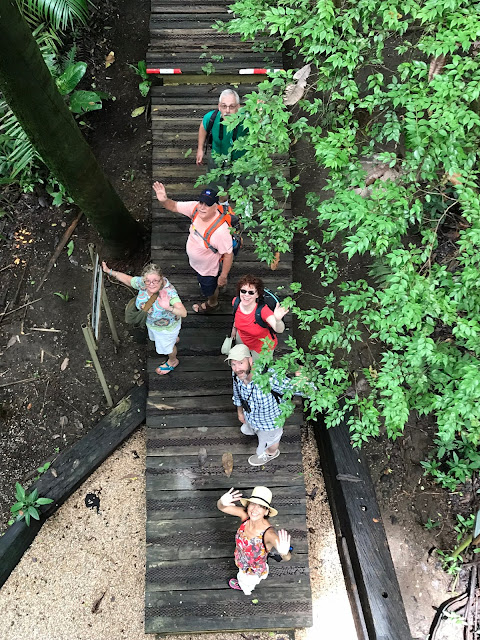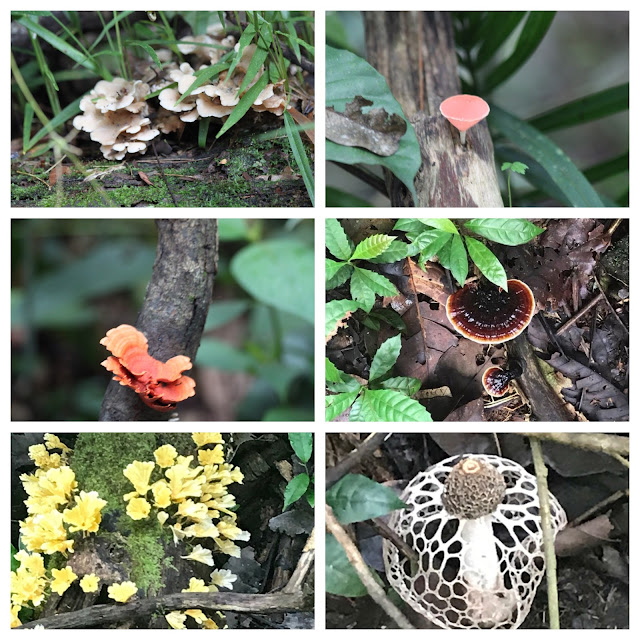Our day began at sunrise with a stop at the Pipeline Road to go birding with world renowned ornithologist, Dr. George Angehr. Dr. Angehr is a retired Smithsonian scientist who now works with the Biomuseo on their biodiversity exhibits. He is also the author of the Birds of Panama field guide.
The Pipeline Road is a world famous site for seeing tropical forest birds. The narrowness of the road allows the tree canopy to continue uninterrupted so birds are easily seen in both the forest, the margin, and overhead. Dr. Angehr said it is not unusual in the dry season to spot 75 birds in the morning with another 40 heard but not seen. We saw a lot of birds with binoculars but they were hard to photograph through the trees.
Dr. Angehr stayed with us as we hiked deeper into the forest where it is highly protected, used by researchers, and we had to sign in with a Panamanian guard.
Dr. Angehr delighted us with his vast knowledge of the tropical forest and all the interconnections in this diverse ecosystem. For example figs are a keystone species that support the entire ecosystem.
By nesting in the figs, wasps help maintain biodiversity and population density. Figs and wasps are mutually dependent on each other. But the fig story doesn’t stop with the wasp. Other animals are also involved in dispersing the seeds such as the agouti, a type of rodent, which we spotted in the underbrush foraging for seeds.
agouti
By nesting in the figs, wasps help maintain biodiversity and population density. Figs and wasps are mutually dependent on each other. But the fig story doesn’t stop with the wasp. Other animals are also involved in dispersing the seeds such as the agouti, a type of rodent, which we spotted in the underbrush foraging for seeds.
agouti
Our hike was a panoply of biodiversity- birds, amphibians, a lizard, fungi, lichens, trees, vines, mosses, egg cases, insects, termite and ant nests, leaf cutter ants, hummingbirds, seeds, mammals. Our senses were assaulted by the sounds, smells, and sights of the rainforest.
A well camouflaged frog
We continued on to The Rainforest Discovery Center which is in the Pipeline Road area on the border of Soberania National Park. A climb up the tower at the Rainforest Discovery Center gave a view of the upper layers of the forest.
Dr. Angehr
Beetles, frogs, and frog foam

Tracing the termite trails beneath the bark up to the nest in the trees

Tracing the termite trails beneath the bark up to the nest in the trees
So many varieties of fungi and lichens
Quotes from Our Group:
It was extraordinary to stop for a limited amount of time and space and spot so many species of birds. We truly experienced what biodiversity is. Caroline B.
I liked how George stood in one place and turned around 360 and said, ‘look where your eyes can see and try to imagine how many species are there’. Scott C.
I was impressed by George’s quote that 90% of bird watching is listening. Scott C.
I was impressed that there’s much more to the fig story than I was aware of. For example, the role of the agouti in distributing the seeds. Page K.
They’ve actually marked the seeds and found that the agouti steal these seeds from one another - one seed can be moved 20 different times to 20 different locations. Carol C.
Dr. Angehr made us aware of the important symbiotic relationship between plants and animals and how animals help to distribute plant DNA. Plants don’t have legs but animals do! John B.
As we ascended the tower at the Rainforest Discovery Center, we appreciated the diversity at different elevations in the rainforest. Scott C.
This hike really opened my eyes to the NGSS crosscutting concept of ‘flow of matter and energy.’ There is no better place to experience this than in the rainforest. Joyce T.
I was amazed by all the different types of lichens and fungi in the rainforest. The decomposers are the critical link in the cycling of matter! Page K.























No comments:
Post a Comment